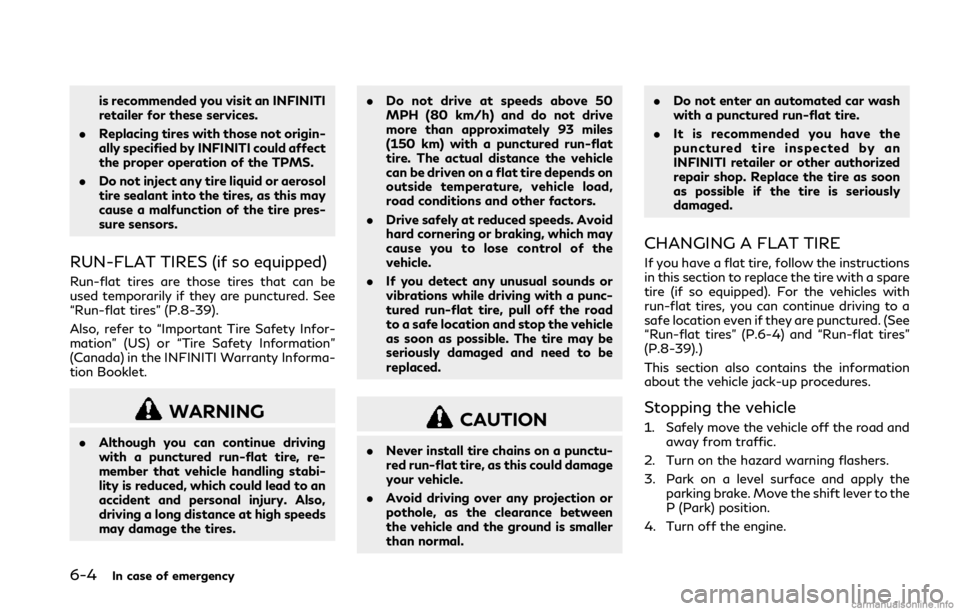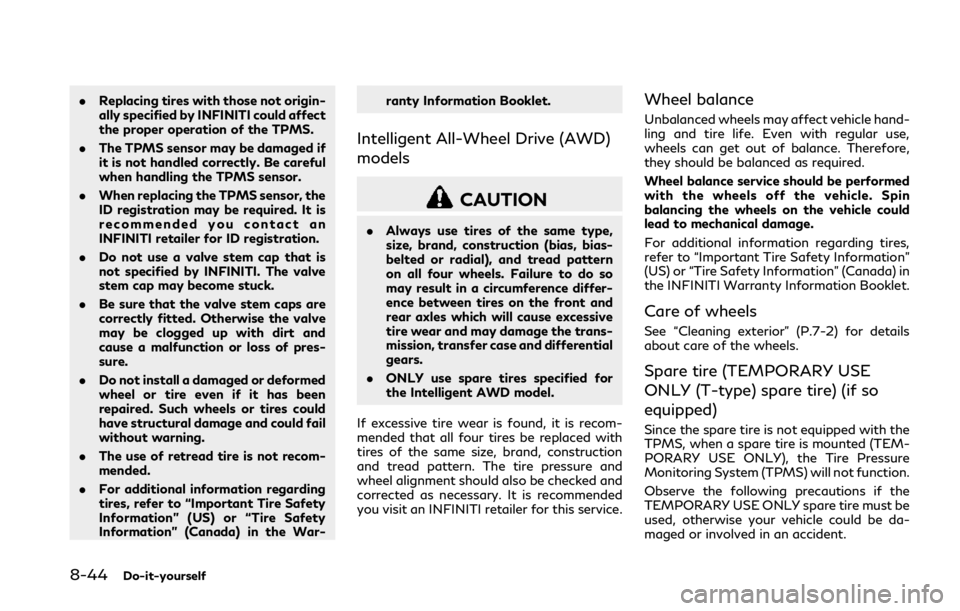sensor INFINITI Q50 2018 Manual PDF
[x] Cancel search | Manufacturer: INFINITI, Model Year: 2018, Model line: Q50, Model: INFINITI Q50 2018Pages: 458, PDF Size: 2.13 MB
Page 315 of 458

5-132Starting and driving
wheel from locking, the system helps the
driver maintain steering control and helps to
minimize swerving and spinning on slippery
surfaces.
Using the system
Depress the brake pedal and hold it down.
Depress the brake pedal with firm steady
pressure, but do not pump the brakes. The
ABS will operate to prevent the wheels from
locking up. Steer the vehicle to avoid
obstacles.
WARNING
Do not pump the brake pedal. Doing so
may result in increased stopping dis-
tances.
Self-test feature
The ABS includes electronic sensors, electric
pumps, hydraulic solenoids and a computer.
The computer has a built-in diagnostic
feature that tests the system each time you
start the engine and move the vehicle at a
low speed in forward or reverse. When the
self-test occurs, you may hear a “clunk”
noise and/or feel a pulsation in the brake
pedal. This is normal and does not indicate a
malfunction. If the computer senses a mal-function, it switches the ABS off and
illuminates the ABS warning light on the
instrument panel. The brake system then
operates normally, but without anti-lock
assistance.
If the ABS warning light illuminates during
the self-test or while driving, have the
vehicle checked. It is recommended you visit
an INFINITI retailer for this service.
Normal operation
The ABS operates at speeds above 3 to 6
MPH (5 to 10 km/h).
When the ABS senses that one or more
wheels are close to locking up, the actuator
rapidly applies and releases hydraulic pres-
sure. This action is similar to pumping the
brakes very quickly. You may feel a pulsation
in the brake pedal and hear a noise from
under the hood or feel a vibration from the
actuator when it is operating. This is normal
and indicates that the ABS is operating
properly. However, the pulsation may indi-
cate that road conditions are hazardous and
extra care is required while driving.
The Vehicle Dynamic Control (VDC) system
uses various sensors to monitor driver inputs
and vehicle motion. Under certain driving
conditions, the VDC system helps to perform
the following functions.
.
Controls brake pressure to reduce wheel
slip on one slipping drive wheel so power
is transferred to a non slipping drive
wheel on the same axle.
. Controls brake pressure and engine out-
put to reduce drive wheel slip based on
vehicle speed (traction control function).
. Controls brake pressure at individual
wheels and engine output to help the
driver maintain control of the vehicle in
the following conditions:
— understeer (vehicle tends to not follow the steered path despite increased
steering input)
— oversteer (vehicle tends to spin due to certain road or driving conditions).
The VDC system can help the driver to
maintain control of the vehicle, but it cannot
prevent loss of vehicle control in all driving
situations.
When the VDC system operates, the VDC
warning light
in the instrument panel
flashes so note the following:
. The road may be slippery or the system
may determine some action is required to
help keep the vehicle on the steered path.
VEHICLE DYNAMIC CONTROL
(VDC) SYSTEM
Page 331 of 458

6-4In case of emergency
is recommended you visit an INFINITI
retailer for these services.
. Replacing tires with those not origin-
ally specified by INFINITI could affect
the proper operation of the TPMS.
. Do not inject any tire liquid or aerosol
tire sealant into the tires, as this may
cause a malfunction of the tire pres-
sure sensors.
RUN-FLAT TIRES (if so equipped)
Run-flat tires are those tires that can be
used temporarily if they are punctured. See
“Run-flat tires” (P.8-39).
Also, refer to “Important Tire Safety Infor-
mation” (US) or “Tire Safety Information”
(Canada) in the INFINITI Warranty Informa-
tion Booklet.
WARNING
.Although you can continue driving
with a punctured run-flat tire, re-
member that vehicle handling stabi-
lity is reduced, which could lead to an
accident and personal injury. Also,
driving a long distance at high speeds
may damage the tires. .
Do not drive at speeds above 50
MPH (80 km/h) and do not drive
more than approximately 93 miles
(150 km) with a punctured run-flat
tire. The actual distance the vehicle
can be driven on a flat tire depends on
outside temperature, vehicle load,
road conditions and other factors.
. Drive safely at reduced speeds. Avoid
hard cornering or braking, which may
cause you to lose control of the
vehicle.
. If you detect any unusual sounds or
vibrations while driving with a punc-
tured run-flat tire, pull off the road
to a safe location and stop the vehicle
as soon as possible. The tire may be
seriously damaged and need to be
replaced.
CAUTION
.Never install tire chains on a punctu-
red run-flat tire, as this could damage
your vehicle.
. Avoid driving over any projection or
pothole, as the clearance between
the vehicle and the ground is smaller
than normal. .
Do not enter an automated car wash
with a punctured run-flat tire.
. It is recommended you have the
punctured tire inspected by an
INFINITI retailer or other authorized
repair shop. Replace the tire as soon
as possible if the tire is seriously
damaged.
CHANGING A FLAT TIRE
If you have a flat tire, follow the instructions
in this section to replace the tire with a spare
tire (if so equipped). For the vehicles with
run-flat tires, you can continue driving to a
safe location even if they are punctured. (See
“Run-flat tires” (P.6-4) and “Run-flat tires”
(P.8-39).)
This section also contains the information
about the vehicle jack-up procedures.
Stopping the vehicle
1. Safely move the vehicle off the road and
away from traffic.
2. Turn on the hazard warning flashers.
3. Park on a level surface and apply the parking brake. Move the shift lever to the
P (Park) position.
4. Turn off the engine.
Page 352 of 458

Occasionally remove loose dust from the
interior trim, plastic parts and seats using a
vacuum cleaner or soft bristled brush. Wipe
the vinyl and leather surfaces with a clean,
soft cloth dampened in mild soap solution,
then wipe clean with a dry soft cloth.
Regular care and cleaning is required in order
to maintain the appearance of the leather.
Before using any fabric protector, read the
manufacturer’s recommendations. Some
fabric protectors contain chemicals that
may stain or bleach the seat material.
Use a cloth dampened only with water, to
clean the meter and gauge lens.
WARNING
Do not use water or acidic cleaners (hot
steam cleaners) on the seat. This can
damage the seat or occupant classifica-
tion sensors. This can also affect the
operation of the air bag system and
result in serious personal injury.
CAUTION
.Never use benzine, thinner, or any
similar material. .
For cleaning, use a soft cloth, dam-
pened with water. Never use a rough
cloth, alcohol, benzine, thinner or any
kind of solvent or paper towel with a
chemical cleaning agent. They will
scratch or cause discoloration to the
lens.
. Do not spray any liquid such as water
on the meter lens. Spraying liquid
may cause the system to malfunction.
. Small dirt particles can be abrasive
and damaging to the leather surfaces
and should be removed promptly. Do
not use saddle soap, car waxes,
polishes, oils, cleaning fluids, sol-
vents, detergents or ammonia-based
cleaners as they may damage the
leather’s natural finish.
. Only use fabric protectors approved
by INFINITI.
. Do not use glass or plastic cleaner on
meter or gauge lens covers. It may
damage the lens cover.
AIR FRESHENERS
Most air fresheners use a solvent that could
affect the vehicle interior. If you use an air
freshener, take the following precautions:
.Hanging-type air fresheners can cause
permanent discoloration when they con-
tact vehicle interior surfaces. Place the
air freshener in a location that allows it
to hang free and not contact an interior
surface.
. Liquid-type air fresheners typically clip
on the vents. These products can cause
immediate damage and discoloration
when spilled on interior surfaces.
Carefully read and follow the manufac-
turer’s instructions before using air fresh-
eners.
FLOOR MATS
WARNING
To avoid potential pedal interference
that may result in a collision, injury or
death:
. NEVER place a floor mat on top of
another floor mat in the driver front
position or install them upside down
or backwards.
Appearance and care7-5
CLEANING INTERIOR
Page 399 of 458

8-44Do-it-yourself
.Replacing tires with those not origin-
ally specified by INFINITI could affect
the proper operation of the TPMS.
. The TPMS sensor may be damaged if
it is not handled correctly. Be careful
when handling the TPMS sensor.
. When replacing the TPMS sensor, the
ID registration may be required. It is
recommended you contact an
INFINITI retailer for ID registration.
. Do not use a valve stem cap that is
not specified by INFINITI. The valve
stem cap may become stuck.
. Be sure that the valve stem caps are
correctly fitted. Otherwise the valve
may be clogged up with dirt and
cause a malfunction or loss of pres-
sure.
. Do not install a damaged or deformed
wheel or tire even if it has been
repaired. Such wheels or tires could
have structural damage and could fail
without warning.
. The use of retread tire is not recom-
mended.
. For additional information regarding
tires, refer to “Important Tire Safety
Information” (US) or “Tire Safety
Information” (Canada) in the War- ranty Information Booklet.
Intelligent All-Wheel Drive (AWD)
models
CAUTION
.
Always use tires of the same type,
size, brand, construction (bias, bias-
belted or radial), and tread pattern
on all four wheels. Failure to do so
may result in a circumference differ-
ence between tires on the front and
rear axles which will cause excessive
tire wear and may damage the trans-
mission, transfer case and differential
gears.
. ONLY use spare tires specified for
the Intelligent AWD model.
If excessive tire wear is found, it is recom-
mended that all four tires be replaced with
tires of the same size, brand, construction
and tread pattern. The tire pressure and
wheel alignment should also be checked and
corrected as necessary. It is recommended
you visit an INFINITI retailer for this service.
Wheel balance
Unbalanced wheels may affect vehicle hand-
ling and tire life. Even with regular use,
wheels can get out of balance. Therefore,
they should be balanced as required.
Wheel balance service should be performed
with the wheels off the vehicle. Spin
balancing the wheels on the vehicle could
lead to mechanical damage.
For additional information regarding tires,
refer to “Important Tire Safety Information”
(US) or “Tire Safety Information” (Canada) in
the INFINITI Warranty Information Booklet.
Care of wheels
See “Cleaning exterior” (P.7-2) for details
about care of the wheels.
Spare tire (TEMPORARY USE
ONLY (T-type) spare tire) (if so
equipped)
Since the spare tire is not equipped with the
TPMS, when a spare tire is mounted (TEM-
PORARY USE ONLY), the Tire Pressure
Monitoring System (TPMS) will not function.
Observe the following precautions if the
TEMPORARY USE ONLY spare tire must be
used, otherwise your vehicle could be da-
maged or involved in an accident.
Page 438 of 458

JVT0530X
Use the following steps to mount the license
plate:
Before mounting the license plate, confirm
that the following parts are enclosed in the
plastic bag.
Only use the recommended mounting posi-
tion, otherwise the radar sensor (Intelligent
Cruise Control (ICC) system) (if so equipped)
obstruction may result.
.License plate bracket
. J-nut × 2
. Screw × 2
. Screw grommet × 2
1. Park the vehicle on flat, level ground.
2. Locate the center position
as illu-
strated. Position the license plate brack-
et at a distance of approximately 0.91 in
(23 mm)
from the bottom of the
bumper. Hold the license plate bracket
in place.
3. Mark the center of the hole
with a felt-
tip pen.
4. Carefully drill two pilot holes using a 0.35 in (9 mm) drill bit at the marked
locations. (Be sure that the drill only
goes through the bumper fascia.)
5. Insert grommets into the hole on the fascia.
6. Insert a flat-blade screwdriver into the
Technical and consumer information10-17
INSTALLING FRONT LICENSE PLATE
Page 452 of 458

Malfunction indicator light (MIL) ..................... 2-17
Map lights .............................................................. 2-55
Master warning light .......................................... 2-14
Mechanical key (Intelligent Key system) .......... 3-3
Memory storageAutomatic drive positioner ......................... 3-33
Meter
Trip computer ................................................. 2-27
Meters and gauges ................................................ 2-6 Instrument brightness control ................... 2-41
Mirror Inside mirror ................................................... 3-30
Outside mirrors .............................................. 3-31
Vanity mirror ................................................... 3-32
Moonroof ............................................................... 2-53
N
NAVI Shift Control .............................................. 5-20
New vehicle break-in ........................................ 5-122
O
Odometer .................................................................. 2-7
Off-road recovery .................................................. 5-9
Oil Capacities and
recommended fluids/lubricants ................. 10-2
Changing engine oil and filter .................... 8-11
Checking engine oil level ............................. 8-11
Engine oil ........................................................ 8-10 One touch unlock sensor (See Intelligent
Key system) ........................................................... 3-10
Operation Indicators for operation ............................... 2-21
Outside air temperature .................................... 2-29
Outside mirrors .................................................... 3-31
Overheat, If your vehicle overheats ............... 6-16
Owner’s Manual/Service Manual
order information ............................................. 10-26
P
Panic alarm ............................................................ 3-18
Parking Parking brake operation .............................. 5-21
Parking on hills ............................................. 5-126
Parking brake break-in ................................... 5-130
Personal lights ...................................................... 2-55
PERSONAL mode ............................................... 5-25
Phone Car phone or CB radio ................................... 4-3
Power
Power door lock ............................................... 3-4
Power outlet ................................................... 2-45
Power steering fluid ..................................... 8-14
Power steering system .............................. 5-127
Power windows ............................................ 2-50
Power moonroof ................................................. 2-53
Power steering warning light ........................... 2-14
Precautions Braking precautions ................................... 5-130
Child restraints ............................................... 1-24 Cruise control ................................................. 5-71
Maintenance ..................................................... 8-3
Seat belt usage .............................................. 1-12
Supplemental restraint system .................. 1-42
When starting and driving ............................ 5-4
Pre-crash seat belts with
comfort function .................................................. 1-14
Predictive Forward Collision
Warning (PFCW) ............................................... 5-112
Push starting ......................................................... 6-16
Push-button ignition switch .............................. 5-11R
Radio Car phone or CB radio ................................... 4-3
Rain-sensing auto wiper system ..................... 2-34
Rapid air pressure loss .......................................... 5-9
Readiness for inspection/maintenance
(I/M) test (US only) .......................................... 10-25
Rear door lock Child safety rear door lock ........................... 3-6
Rear seats ................................................................. 1-5
Rear window and outside mirror
defroster switch ................................................... 2-35
Recorders Event data .................................................... 10-25
Registering your vehicle in
another country ................................................ 10-14
Remote engine start ........................................... 3-20
Remote keyless entry system .......................... 3-16
Reporting safety defects ................................ 10-24
11-5